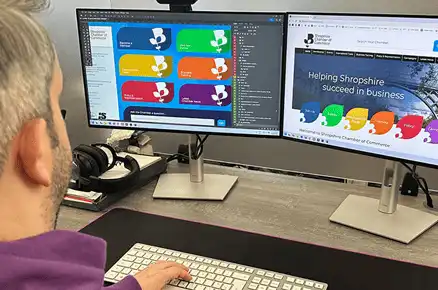Sort Your Cyber Security
Cyber threats are not just a problem for big companies and governments.
Small businesses are just as likely to be targeted and cyber attacks can put your money, data and IT equipment at risk.
Staying one step ahead of the hackers is an evolving challenge so we’ve put together a few tips to help you keep your website safe and secure.
What is the most serious threat to website cyber security?
Not keeping website software up to date is by far the largest reason for security breaches of websites. This could be in the software itself, or through a 3rd party plugin. It’s important to promptly install any software updates which contain security fixes.
Once a security vulnerability is exposed publicly it’s only a matter of time until a bad actor starts to look for websites to exploit.
Software that is known to have security vulnerabilities but doesn’t offer an update to address any issues within a reasonable timeframe should be classed as abandonware and should therefore be replaced.
What other security threats are out there?
Phishing attacks:
Phishing attacks involve sending emails or messages that appear to be from a legitimate source, such as a bank or a company, to trick recipients into revealing their login credentials, personal information, or financial details. Phishing attacks are one of the most common sources of security breaches.
Weak passwords:
Weak or easily guessable passwords can be easily cracked, allowing hackers to gain access to sensitive information. Companies and organisations should encourage employees to use strong passwords and implement policies that require password changes periodically.
Unpatched software vulnerabilities:
Unpatched vulnerabilities in software and applications can be exploited by attackers to gain access to systems and steal data. Companies and organisations should regularly update their software and patch any known vulnerabilities.
Malware:
Malware, such as viruses, worms, and trojans, can infect systems and steal sensitive data. Malware can be delivered via email, infected websites, or through physical media such as USB drives.
Insider threats:
Insider threats can come from employees, contractors, or other trusted individuals with access to sensitive information. Insider threats can include intentional theft of data, accidental disclosure, or negligent behaviour that compromises security.
Social engineering:
Social engineering involves manipulating individuals to disclose sensitive information or perform actions that compromise security. Social engineering techniques can include impersonating someone in authority, creating a sense of urgency, or exploiting personal relationships.
Physical security breaches:
Physical security breaches can occur when unauthorised individuals gain access to restricted areas or steal physical assets such as laptops, mobile phones, or other devices containing sensitive information. Companies and organisations should implement physical security measures such as access controls, CCTV, and security patrols.
How to maintain your cyber security
Implement a robust cyber security policy:
Develop a comprehensive cyber security policy that outlines best practices, guidelines, and procedures for all employees. This policy should cover areas such as password management, acceptable use of technology, data handling, incident response, and employee training.
Conduct regular employee training and awareness programs:
Educate employees about cyber security threats, best practices, and how to recognise and respond to potential risks. Provide training on topics such as phishing awareness, social engineering, secure password creation, and safe browsing habits.
Implement strong access controls:
Enforce strong authentication mechanisms, including the use of complex passwords, multi-factor authentication (MFA), and privileged access management (PAM). Limit access privileges to only those employees who require it for their specific roles.
Regularly update and patch systems:
Keep all software, applications, and operating systems up to date with the latest security patches. Regularly review and apply updates and patches from software vendors to address vulnerabilities and protect against known threats.
Use firewall and antivirus solutions:
Deploy and maintain firewall systems to monitor and control incoming and outgoing network traffic. Install and update antivirus software to detect and prevent known malware and other threats.
Secure network infrastructure:
Ensure that your network is properly secured by using encryption protocols, virtual private networks (VPNs), and intrusion detection/prevention systems (IDS/IPS). Segment your network to limit the impact of a potential breach.
Regularly back up critical data:
Perform regular backups of important data and verify their integrity. Store backups in secure locations, separate from the production environment. Test the restoration process to ensure data can be recovered effectively.
Monitor and analyse network activity:
Implement a system for monitoring network activity, including intrusion detection systems (IDS) and security information and event management (SIEM) solutions. Monitor logs and set up alerts to quickly identify and respond to potential security incidents.
Conduct regular security assessments and penetration testing: Engage third-party security professionals to perform regular security assessments and penetration testing to identify vulnerabilities and weaknesses in your systems. Address the identified issues promptly.
Have an incident response plan:
Develop an incident response plan that outlines the steps to be taken in case of a security incident. This plan should include procedures for identifying, containing, eradicating, and recovering from a breach, as well as communication protocols for notifying stakeholders.
Need extra support?
Remember that cyber security is an ongoing process, and it requires continuous monitoring, updating, and adaptation to address evolving threats. It is crucial to stay informed about the latest cyber security trends and best practices, and to regularly reassess and improve your security measures as needed.
Clickingmad has just been re-accredited to the ISO 270001 standard for its information security management system so you can rest assured that any website we build and host will remain secure.
Our continued commitment to our security procedures in line with the ISO 27001 standard not only protects our own data but also protects that of our clients by demonstrating our commitment to information security, providing a framework for information security management, enhancing client confidence, improving risk management, and providing a basis for compliance with data protection regulations.






News and Insights
Sign up for updates